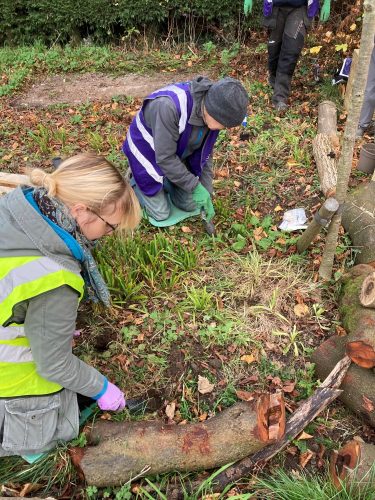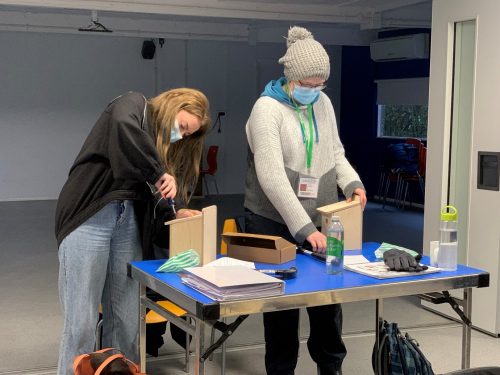Ready, steady, GO… new Wildlife Champions come together to begin creation of a 10 mile Nature Recovery Corridor.
Having received a Green Recovery Challenge Fund grant earlier this year we launched the first of 6 Wildlife Champions courses for the Nature Recovery Corridor project in November. These courses are just one aspect that will contribute to making the zoo’s ambitious plan for a 10 mile Nature Recovery Corridor a reality.
Who are Wildlife Champions?
Our exciting new Nature Recovery Corridor project is working to create and enhance green spaces across a 10 mile stretch of Cheshire and make them better for wildlife. But this isn’t something we can do alone. We’re training a taskforce of Wildlife Champions who have green space and are keen to do more for wildlife within those spaces. This taskforce is made up of various people that belong to different community groups all of which have a green space with the potential to be managed for wildlife.
Our champions come from various backgrounds and have different starting levels of wildlife knowledge but what they all have in common is an interest in developing their knowledge and skills in wildlife gardening. We have teachers looking to improve their school grounds, local residents who volunteer at their local park and uniform group leaders wanting to get tips for engaging their groups with wildlife. And they’re all coming together to help us achieve something great!
Why are we running these courses?
Wildlife across the UK is under threat, many species are struggling to thrive or even undergoing population declines. One threat common to much of our threatened wildlife is habitat loss. This means that any space we can preserve, enhance and create for wildlife can be of real conservation value. That’s why we’re keen to share our knowledge about making your green space the best habitat possible for wildlife.
Another related threat is habitat fragmentation. By creating a network of Wildlife Champions who share their passion across their groups and communities we can create a corridor of connected wildlife friendly spaces that facilitate the movement of wildlife and provides that all important connectivity which can be a major limiting factor for many species. This is the power of communities coming together!
What have the champions done so far?
As a part of the Wildlife Champions training course that started in November the team have been introduced to skills, knowledge and resources such as honing their DIY skills crafting animal homes ready to take back to their own communities and green spaces. And our first cohort of Champions are already hard at work doing their bit for nature as they’ve also been given the opportunity to develop their skills at the zoo, creating a wildlife and wellness garden.
This zoo garden is very much a work in progress and it’ll be evolving throughout the year as more Champions are trained and leave their mark. So stay tuned for further updates on how our garden is taking shape and for ideas of what you can do to help wildlife in your garden at different times of year.
“The course leaders are generous with time, suggestions…and bird boxes!”

We kicked things off in the garden by grubbing around together planting a variety of species including spring bulbs to provide food for early emerging pollinators and bushy perennials to provide shelter for overwintering invertebrates. Planting is core to any wildlife garden as plants can provide food and shelter for many species, especially invertebrates, who then in turn provide a banquet for other animals such as bats, hedgehogs and birds who are higher up the food chain.
“I have really enjoyed learning about the different ways to help wildlife-learning what to plant and when for example is invaluable.”
We’ve also been getting bug-friendly in other ways. Our Champions collaborated on a grand bug hotel for the wildlife and wellness garden to provide a variety of habitats for an array of tiny critters. And having now learnt the necessary skills we can’t wait to see what bug hotels our Champions design for their own green areas…watch this space (hopefully we’ll see some updates popping up on our community hub where anyone can share what they’ve done for nature).
“It’s been helpful to discuss and try activities and resources whilst considering the practicalities of community engagement.”
What will happen next?
Our first cohort of Nature Recovery Corridor Wildlife Champions are getting close to graduating with just one more training session to go learning all about bats, toads and hedgehogs BUT it doesn’t end there! One of the greatest benefits of being a Wildlife Champion is making valuable contacts and building up a community of like-minded people who are keen to do their bit for nature and are excited to support each other with this important mission as they head back to their communities and green spaces. This network is core to creating the 10 miles of wildlife spaces for our Nature Recovery Corridor!

“I really enjoyed the session, it was useful, informative and hands-on. It was also good to meet with other groups and exchange info and ideas.”
You can find out more about our Nature Recovery Corridor and if you think you’d make a great champion for wildlife why not sign up to one of our Wildlife Champion courses. You can also follow some of our how-to guides to enhance your own green space, together we can make a difference and prevent extinction!
WILDLIFE CONNECTIONS
By creating connections from one wildlife-friendly space to the next we can create wildlife highways through our neighbourhoods and protect the precious wildlife that we love. You can make small changes that will make a BIG difference.